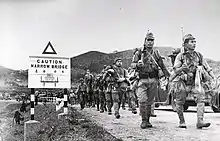| 38th Division | |
|---|---|
 Soldiers of the 228th Regiment of 38th Division entering Hong Kong, December 1941 | |
| Active | 1939–1945 |
| Country | Empire of Japan |
| Branch | |
| Type | Infantry |
| Garrison/HQ | Nagoya, Japan |
| Nickname(s) | Swamp Division |
| Engagements | Battle of Hong Kong Dutch East Indies campaign Guadalcanal campaign New Georgia Campaign New Britain campaign Admiralty Islands campaign |
| Commanders | |
| Notable commanders | Tadayoshi Sano Yoshimitsu Abe Takeo Itō |
The 38th Division (第38師団, Dai sanjūhachi shidan) was an infantry division of the Imperial Japanese Army, activated 30 June 1939 in Nagoya,[1] simultaneously with the 39th, 40th and 41st Divisions. Its call sign was the Swamp Division (沼兵団, Numa Heidan).
Action
The division was initially assigned in October 1939 to the 21st Army to provide security services in Guangdong province in the wake of Imperial Army's Canton Operation. On 9 February 1940 the 21st Army was dissolved and 38th Division was reassigned to South Army. On 28 June 1941 the South Army was also dissolved and the 38th Division was incorporated into the 23rd Army.
The division saw heavy action during the Pacific campaign of World War II. Its main combat units were three infantry regiments: the 228th, 229th and 230th. These were supported by the 38th Mountain Artillery Regiment, the 38th Engineer Regiment, the 38th Transport Regiment and a tankette company.[2]
Initially, the division participated in conquest of Hong Kong in 1941.[1] On 4 January 1942, the 38th Division was assigned to the 16th Army and its 230th Infantry Regiment (converted for this occasion into the 3rd Mixed Regiment) took part in the Battle of Java (1942). In November 1942 the 3rd Battalion of the 229th Infantry Regiment was sent to participate in the New Guinea campaign, where by January 1943 it was completely decimated following multiple engagements on the island chain with Australian forces.
The remnants of the division fell back to Rabaul after these losses and took part in the fortification of the port. From October 1942 to February 1943, the rest of 38th Division also took heavy losses in the Guadalcanal Campaign and was thereafter assigned to the defense of the New Georgia, the Admiralty Islands, New Britain, and New Ireland occupational garrisons until the end of the war. In particular, the 229th Infantry Regiment participated in the New Georgia Campaign throughout July and August.[1] The majority of the 38th Division capitulated after the surrender of Japan on 15 August 1945 in Rabaul.
The division's soldiers were accused of committing war crimes during their operations in the Pacific theater.[3] One of the division's senior officers, Takeo Itō, was convicted of war crimes by an Allied military tribunal after the war.[4]
See also
References
- This article incorporates material from the Japanese Wikipedia page 第38師団 (日本軍), accessed 18 March 2016
Footnotes
- 1 2 3 Rottman 2005, p. 10.
- ↑ Rottman 2005, p. 15.
- ↑ Budge, Kent. "Takeo Ito". Pacific War Online Encyclopedia.
- ↑ Some Noteworthy War Criminals Archived 9 March 2009 at the Wayback Machine Source: History of the United Nations War Crimes Commission and the Development of the Laws of War, United Nations War Crimes Commission (London: HMSO, 1948)
Books
- Frank, Richard (1990). Guadalcanal: The Definitive Account of the Landmark Battle. New York: Random House. ISBN 0-394-58875-4.
- Fuller, Richard (1992). Shokan: Hirohito's Samurai. London: Arms and Armour Press. ISBN 1-85409-151-4.
- Griffith, Samuel B. (1963). The Battle for Guadalcanal. Champaign, Illinois, US: University of Illinois Press. ISBN 0-252-06891-2.
- Rottman, Gordon L. (2005). Japanese Army in World War II: The South Pacific and New Guinea, 1942-43. Oxford and New York: Osprey. ISBN 1-84176-870-7.
- United States War Department (1991) [reprint of 1944 edition]. Handbook on Japanese Military Forces. David Isby (Introduction) and Jeffrey Ethell (Afterword). Baton Rouge and London: Louisiana State University Press. ISBN 0-8071-2013-8.
Web
- Ammentorp, Steen. "Sano, Tadayoshi, Lieutenant-General".
- Budge, Kent G. "Sano Tadayoshi (1889–1945)".
- Japanese army operations in the South Pacific Area New Britain and Papua campaigns, 1942–43. Senshi Sōshō (translated excerpts). Translated by Bullard, Steven. Canberra: Australian War Memorial. 2007. ISBN 978-0-9751904-8-7. See p. 163 for a breakdown of the division's organization in September 1942.
- Hough, Frank O.; Ludwig, Verle E.; Shaw, Henry I. Jr. "Pearl Harbor to Guadalcanal". History of U.S. Marine Corps Operations in World War II.
- Miller, John Jr. (1995) [1949]. Guadalcanal: The First Offensive. United States Army In World War II. United States Army Center of Military History. Archived from the original on 25 December 2007. Retrieved 4 July 2006.
- Shaw, Henry I. "First Offensive: The Marine Campaign For Guadalcanal". Marines in World War II Commemorative Series.
- World History Database (1999–2000). "Tadayoshi Sano". Archived from the original on 15 May 2008. Retrieved 5 March 2009.
- Zimmerman, John L. (1949). "The Guadalcanal Campaign". Marines in World War II Historical Monograph.